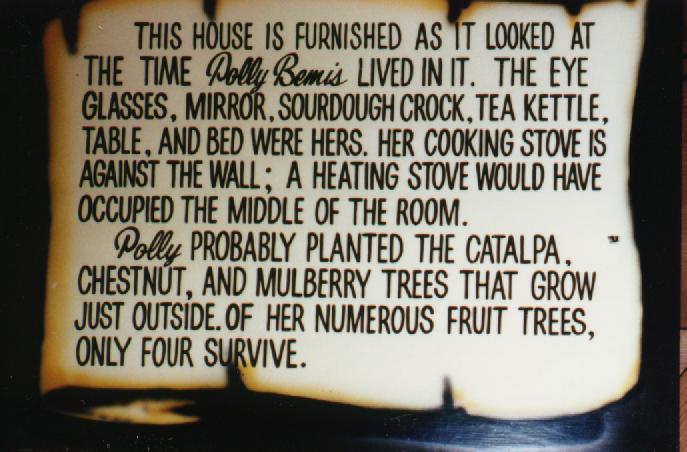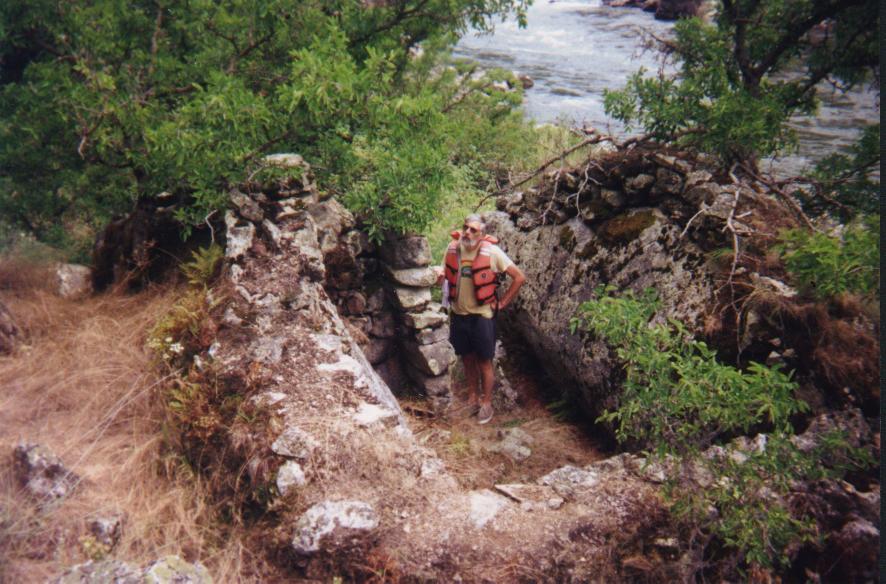
Asian American Comparative Collection:
Classes and Tours
Asian American Comparative Collection (AACC)
University of Idaho
875 Perimeter Drive, MS 1111
Moscow, Idaho 83844-1111 USA
208-885-7075
|
Priscilla Wegars, Ph.D., Volunteer Curator
pwegars@uidaho.edu
Renae Campbell, M.A., RPA, Research Assistant
rjcampbell@uidaho.edu |
Classes and Tours
The descriptions below are of trips that have been successfully
offered in the past. Please inquire if you are interested in
any of them.

Sign inside Polly Bemis's cabin. Photo by P. Wegars.
The World of Polly Bemis
Brief
Description: Idaho's most remarkable pioneer Chinese woman,
Polly Bemis, arrived in 1872. Following their 1894 marriage, she
and Charlie Bemis took up a mining claim, not a homestead, on the
remote Salmon River. Their first cabin burned in 1922, and
Charlie died shortly afterwards. Polly's neighbors built another
cabin for her, where she lived until just before her death in
1933. It is now on the National Register of Historic Places.
During this three-day, two-night adventure into rugged north
central Idaho we visited
Polly Bemis's cabin and grave, and
Charlie Bemis's grave on the main Salmon River, today easily
accessible only by jet boat. We also visited Lewiston's
Beuk
Aie Temple, now restored and on permanent exhibit at the
Lewis-Clark Center for Arts & History in Lewiston, as well as
The Historical Museum at St. Gertrude in Cottonwood, where
some of Polly's personal possessions are housed. A detailed
itinerary from a previous trip may be viewed
here.

Chinese rock house near Half and Half Rapids,
Lower Salmon River. Photo by P. Wegars.
Chinese Mining on the Lower Salmon
River
Trip
Description: Chinese miners first arrived in north central
Idaho in the 1860s to work in the newly-discovered gold fields,
some of which were on the remote, roadless, lower Salmon River.
Today, many signs of their presence can still be seen, including
some striking remains of rock dwellings. During this
three-day, two-night float trip and rafting adventure, a brief
layover at Packers Creek enabled us to examine Chinese
miners' rock dwellings, hydraulic workings, man-made reservoirs,
and Chinese artifacts. We also visited other Chinese sites
along this 55-mile stretch of the Salmon and Snake rivers.
Participants also sampled Chinese culture and cuisine,
tried their luck at gold panning and Chinese games,
and learned to identify Chinese artifacts.
Chinese
Pioneers in the Northwest
Trip
Description: This
two day, one night adventure into northeastern Oregon featured
visits to Baker City's Chinese cemetery and to the
world-renowned Kam Wah Chung and Company Museum in John
Day, now an Oregon State Park. Its isolated location has
helped preserve this fully-furnished store and herbal medicine
shop dating to the late nineteenth and early twentieth
centuries. We also explored two unique archaeological sites
created by mid- to late nineteenth-century Chinese placer
miners. One, called the Ah Hee Diggings (earlier
known as the "Chinese Walls"), comprises some 16 acres of
hand-stacked, wall-like, rock tailings. The other, at Union
Creek, has an impressive three-tiered, rock-walled, water
delivery channel, originally fed by two earthen dams.
Return to AACC
February 2016/tours.htm/pwegars@uidaho.edu


